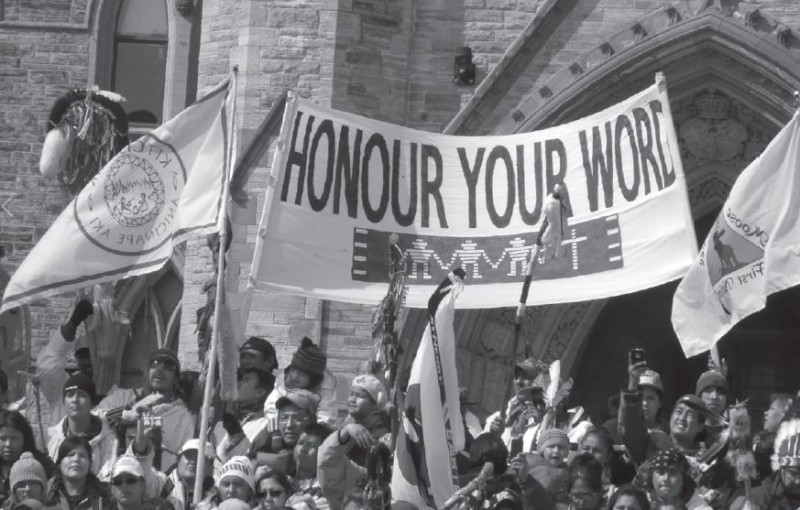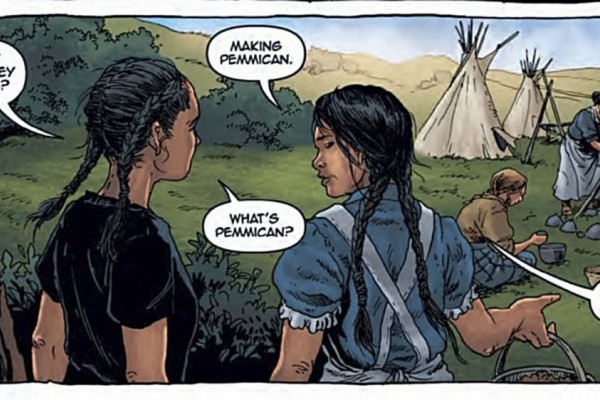Trees and teargas: Worldviews clash at Barriere Lake
Events from a chilling October day in 2008, on a gravel road entering Algonquin First Nation bush territory, epitomize the contentious history of jurisdiction in what is now known as Canada. Riot cops teargassed the community standing at a blockade and arrested nine people, including two minors, an elder, and a pregnant woman. The alarming story of Barriere Lake reveals much about the tactics and devices used by the state to continue its dispossession of Indigenous peoples’ land.
The contemporary methods and “techniques” of stonewalling and forceful property acquisition are outlined in this book by Shiri Pasternak. She is assistant professor in Criminology at Ryerson University and has worked closely in solidarity with the community of Barriere Lake, Québec for many years. The book is recommended reading for those interested in understanding the ways in which colonial law continues to overrule and extinguish Indigenous rights while undermining efforts towards meaningful reconciliation. Through the case study of Barriere Lake, an Algonquin First Nation located north of Ottawa on Highway 117, Pasternak outlines the ongoing dispute and the modern day mechanisms of the state to suppress dissent.
But how did we get here? At a time when the word “reconciliation” rolls so easily off the slippery tongues of Canada’s elected offi cials, how did we come to a place where, simultaneously, a respected band council member is hospitalized from wounds left by a tear gas canister launched by a militarized member of the police?
To begin, Pasternak outlines the ways in which Anishnawbe law differs from European property laws. Using western concepts of property rights and ownership as a technique of jurisdiction to obtain lands for resource extraction and settlement has long been a practice of provincial and federal governments. Property acquisition laws have stood in direct opposition to Indigenous customary law, or Onakinakewin — the sacred constitution of the Anishnawbe.
Jurisdiction is thought of under Onakinakewin as a “kinship-based care” that ensures the protection of the land for future generations through actions of reciprocity. “Property,” however, does not concern itself with future land use. Instead, colonial modes conceptualize the natural world as a standing reserve, immediately available for extraction and capital accumulation.
Understanding these contrasts is important in understanding what has happened at Barriere Lake; it is not just a question of land jurisdiction, but a question of governance and sovereignty. Some 10,000 square kilometres of land are used by the Algonquins for hunting, fi shing, trapping and harvesting is often contested by mining activities and logging. Recognizing this, the customary government of Norman Matchewan made an attempt in the early 1990s to rectify the situation by introducing the concept of a Trilateral Agreement, a method of power-sharing signed between Barriere Lake, Québec and Canada that would respect local knowledge and use it as a guide for future developments.
March 25, 2013:
Barriere Lake youth
join with youth of
Nishiyuu in protest at
Parliament Hill. Photo
by Warren McBride.
The United Nations called the Trilateral Agreement a “trailblazer” as it outlined concepts coinciding with the popular ideas of sustainability while respecting Indigenous knowledge and sovereignty. The Royal Commission on Aboriginal Peoples called it “a model for co-existence.” What could have been used as a conduit for meaningful reconciliation and a roadmap for peaceful coexistence instead was ignored as Québec continued to license multinational corporate logging on sacred and ecologically sensitive lands explicitly outlined as off-limits in the agreement.
These events were to be the seed of a string of coercive, forceful actions taken by Québec and Canada to supersede traditional law from Barriere Lake, the main weed in a fi eld of industrial growth. While infi ghting over leadership sprung up after Indian Act legislation was enacted, INAC introduced Third- Party Management, a common practice enforced by federal authorities when a community appears divided on leaders. This tactic allowed the federal government to regain resource control as Barriere Lake watched their local education and other internal, self-governing systems disintegrate.
The loss of agency over their fi nances has especially had material implications on the community. At the same time, surveillance systems of settler authorities were installed into the First Nation’s back yard. Illegal mining on Barriere Lake territory commenced in 2011. Today, the struggle continues back and forth. Most recently, in 2017, Québec allowed for a suspension to be placed on Copper One’s exploration activities in the territory; however, the mining company asserts its will in continuing to search the land for copper.
Despite these recent gains, Pasternak points out that the face of colonization, as it exists today, comes in the form of Third Party Management. Modern colonialism is also evidenced through images of teargassed teenagers and handcuffed elders. The legal jurisdiction of space, whether through soft force such as leveraging of funds and delegitimizing traditional councils or through overt force by the activation of riot cops on Indigenous land, becomes the tactic used by the government to continue industrial development of aboriginal territories.
A coordinating editor of Canadian Dimension, Kim works as an adult educator facilitating an Academic Upgrading class with Alexandra Park Neighbourhood Learning Centre in Toronto’s west end. She holds a Master of Arts degree in Canadian Studies and Indigenous Studies from Trent University.
This article appeared in the Spring 2018 issue of Canadian Dimension (Whiteness & Racism).










